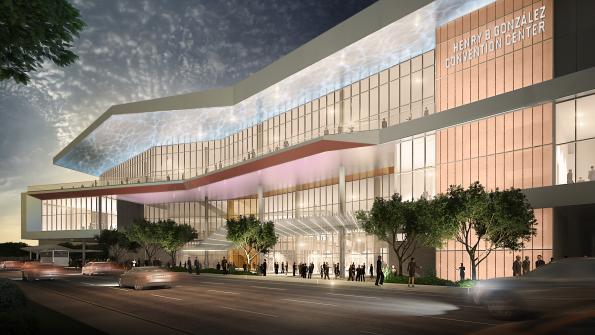Expo in the City: Urban Convention Centers Heat Up
Recent growth trends in the exhibition industry – combined with attendees’ preferences for urban locations – are creating significant opportunities for convention centers in the hearts of vibrant cities. While urban facilities are inevitably more expensive to build, they are also more lucrative, because they provide an edge in attracting new events and deliver strong economic returns to the communities that build them.
Each year, top cities around the world compete for the largest and most profitable conventions and the competition is fierce. Financing and construction in the exhibition industry showed strong growth in 2014, while 2015 has seen major gains in revenues, demand and attendance, according to a recent study released by the Center for Exhibition Industry Research.
Globally, convention center revenue growth has outpaced world GDP each year, with the growth rate almost doubling to 5.8 percent in 2014, according to International Association of Convention Center numbers. This robust growth continues to bring new prospects to communities vying for these mega-events, raising the stakes even higher.
Better Benefits and ROI
Many communities are recognizing the benefits of booking convention business, and are investing in new buildings and expansions to accommodate them. Cities investing most heavily and frequently are those that can capitalize on their market strengths and land these events. In this game, central city locations dominate.
Great destinations win the largest events, and the expansions moving forward today, which typically require significant public investment, are almost exclusively in urban settings. The amenities offered by the most competitive destinations must be superior – local restaurants, shopping, entertainment, nightlife and the elusive ‘urban vibe’ are all expected – and events hosted in city centers with these features are better attended. Downtown Nashville fits the bill perfectly, and its recent expansion enjoys this advantage. Even before its 2013 opening, Music City Center bookings had exceeded one million room nights.
These facilities also generate higher economic and fiscal returns for the communities that fund them. Downtown hotels typically have higher rates, so when convention delegates stay in these urban locations, their higher spending results in higher room tax revenues, which feed the local economy. In addition, many convention centers exist within special tax districts with sales tax rates higher than the surrounding areas. As a result, convention delegates’ spending produces higher sales tax collections and overall revenue, especially for local businesses.
Although urban convention centers are more attractive to meeting planners and convention attendees, and have a greater chance of generating the economic returns promised to the community, they are also more expensive to build; however, owners and project teams can manage costs by implementing several strategies.
 Vertical Stacking
Vertical Stacking
Urban convention centers are built vertically – a result of constrained sites, premium land prices, and a desire to maintain a walkable street grid. Exhibition halls and meeting rooms that would otherwise be placed end-to-end are stacked on top of one another, and the extra space required for escalators, elevators and stairs results in higher costs.
A related issue that drives up costs is the excavation and shoring required for buildings that are partially underground. Depending on the cost of construction materials, this can be offset by savings in structural steel and building enclosure. This is, however, difficult to forecast ahead of time.
Showpiece Buildings
A city’s convention center is often seen as a symbol of community pride. Expanding and embellishing a property to showcase it can become expensive. A facility may not need retail and restaurants at the street level, and building codes may not require lush landscaping and high-quality finishes, but often politics and negotiation can require that these features become part of the mix. Public art, sustainability and energy efficiency features, while important to public buildings, can also drive up costs. Because of this, it’s important to identify potential project ‘add-on’ requirements early and understand their cost implications. Communicate these costs consistently, question any discrepancies and seek alternative funding sources where possible.
Neighbor Issues
Rightly so, neighboring business owners, workers, residents and visitors demand restricted work hours, limited hours for deliveries, restrictions on street and sidewalk closures and mitigation measures to protect adjacent buildings from damage or disruption. Increased costs can result from the need for construction site security, additional construction fencing, traffic control personnel and dust control.
City parking fees are typically more expensive than in the suburbs. Without a proactive plan, contractors and subcontractors will park at city meters or in nearby residential neighborhoods to the annoyance of downtown businesses and local residents. Where possible, owners should negotiate parking arrangements with downtown garages so the onslaught of construction workers arriving at 5 a.m. and leaving at 3 p.m. every day isn’t too disruptive.
Going Forward
The growth trends and future prospects for convention centers – particularly those in thriving central cities – are strong. Attendees prefer urban destinations with amenities that make destinations interesting and vibrant. The data demonstrates this fact, communities understand and embrace it and city leaders and voters alike are responding by investing in these projects. While construction in central cities carries a cost premium, the benefits and ROI of these projects more than outweigh the incremental cost.
Scott Sumners is a leader for Rider Levett Bucknall’s project management services. Scott has over 20 years of experience in urban development, with a concentration in large public projects, including the $600 million Phoenix Convention Center Expansion, the PHX Sky Train at Sky Harbor International Airport and the new ASU Law School in downtown Phoenix. Scott can be reached via email.




















